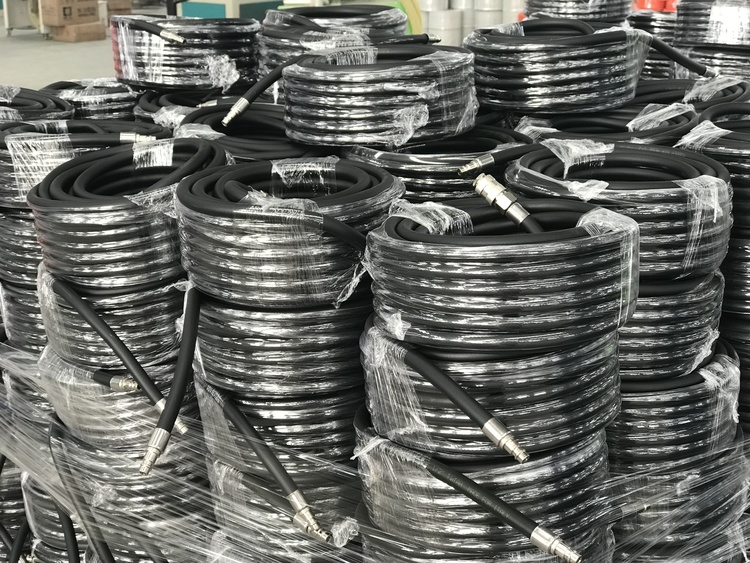Introduction
When it comes to powering pneumatic tools and machinery, a reliable air compressor is essential. However, even the most powerful compressor won’t perform optimally without a high-quality air compressor hose. This often-underestimated component plays a critical role in delivering pressurized air effectively. In this comprehensive guide, we’ll delve into every aspect of air compressor hoses, ensuring you’re equipped with the knowledge needed to make informed choices. From materials and sizing to maintenance and safety, we’ve got you covered.

black compressor air hose
Air Compressor Hose: A Crucial Element for Efficiency
Whether you’re a DIY enthusiast or a professional mechanic, ensuring your air compressor functions efficiently is paramount. The air compressor hose serves as the vital link between your compressor and the tools or equipment you’re operating. It’s responsible for transporting the compressed air from the machine to the point of use, making its quality and characteristics crucial for optimal performance.
Choosing the Right Air Compressor Hose
Understanding Hose Materials
Selecting the right material for your air compressor hose is fundamental. Rubber, PVC, and polyurethane are the most common options available. Rubber is durable and flexible, making it suitable for heavy-duty applications, while PVC is lightweight and cost-effective. Polyurethane strikes a balance between the two, combining flexibility with resistance to abrasion and chemicals.
Hose Diameter and Length
The diameter and length of your air compressor hose impact the air delivery rate. A larger diameter allows for higher airflow, while a longer hose may lead to pressure loss. Consider the specific requirements of your tools and workspace when determining the optimal diameter and length.

Inner diameter and length of hose
Fittings and Connectors
Fittings and connectors play a crucial role in maintaining a secure and leak-free connection between the hose and the compressor or tool. Quick-connect couplers provide convenience and time-saving benefits, allowing for swift changes between tools.
Working Pressure and Burst Pressure
Understanding the working pressure and burst pressure ratings of your hose is vital to prevent safety hazards. Working pressure refers to the continuous pressure the hose can handle, while burst pressure indicates the maximum pressure it can withstand momentarily. Always choose a hose with a working pressure higher than your air compressor’s output.
Temperature and Compatibility
Consider the environment in which you’ll be using the air compressor hose. Some hoses are better suited for specific temperature ranges, while others are compatible with oil-laden air. Ensure the hose material can withstand the conditions it will be exposed to.

Temperature
Maintaining Your Air Compressor Hose
Regular Inspection
Frequent visual inspections are essential to identify signs of wear, damage, or leaks. Replace the hose if you notice cracks, bulges, or exposed reinforcement.
Proper Storage
Store your air compressor hose away from direct sunlight and extreme temperatures. Coiling the hose and using hose reels can prevent kinks and prolong its lifespan.
Cleaning and Drying
Keep your hose clean and free from debris, as particles can affect airflow and damage the hose interior. After use, drain any accumulated moisture to prevent corrosion.
Safety Precautions and Best Practices
Eye Protection
When using pneumatic tools, wear appropriate eye protection to shield your eyes from debris and potential hose ruptures.
Distance Awareness
Maintain a safe distance from the hose while it’s under pressure, as a sudden burst can cause injury.
Relief Valves
Consider installing relief valves to prevent excessive pressure buildup, reducing the risk of hose failure.
Secure Anchoring
Anchor your hose securely to prevent it from becoming a tripping hazard or being caught in moving machinery.
Q: How often should I replace my air compressor hose?
A: Regularly inspect your hose for signs of wear and replace it if you notice any damage. On average, hoses should be replaced every 3 to 5 years.
Q: Can I extend the length of my air compressor hose?
A: While it’s possible to extend the length using couplers, keep in mind that longer hoses can lead to pressure loss and reduced efficiency.
Q: Are all air compressor hoses the same?
A: No, hoses vary in material, diameter, and compatibility. It’s essential to choose a hose that suits your specific needs.
Q: Can I repair a damaged hose?
A: Minor damages can sometimes be repaired using hose repair kits, but it’s generally safer to replace a damaged hose.
Q: Can I use a regular hose for my air compressor?
A: No, regular hoses aren’t designed to withstand the high pressures of compressed air and can pose safety risks.
Conclusion
Investing in the right air compressor hose is essential for ensuring the efficiency and safety of your air delivery system. By considering factors such as materials, diameter, length, and safety precautions, you can optimize your pneumatic tools’ performance and extend the lifespan of your hose. Regular maintenance and adherence to safety practices further contribute to a seamless and secure air compression experience.
Remember, the air compressor hose acts as the lifeline of your pneumatic operations. With the right hose in place, you’re poised for efficient and reliable performance in all your endeavors.

 sunhose
sunhose sunhose
sunhose